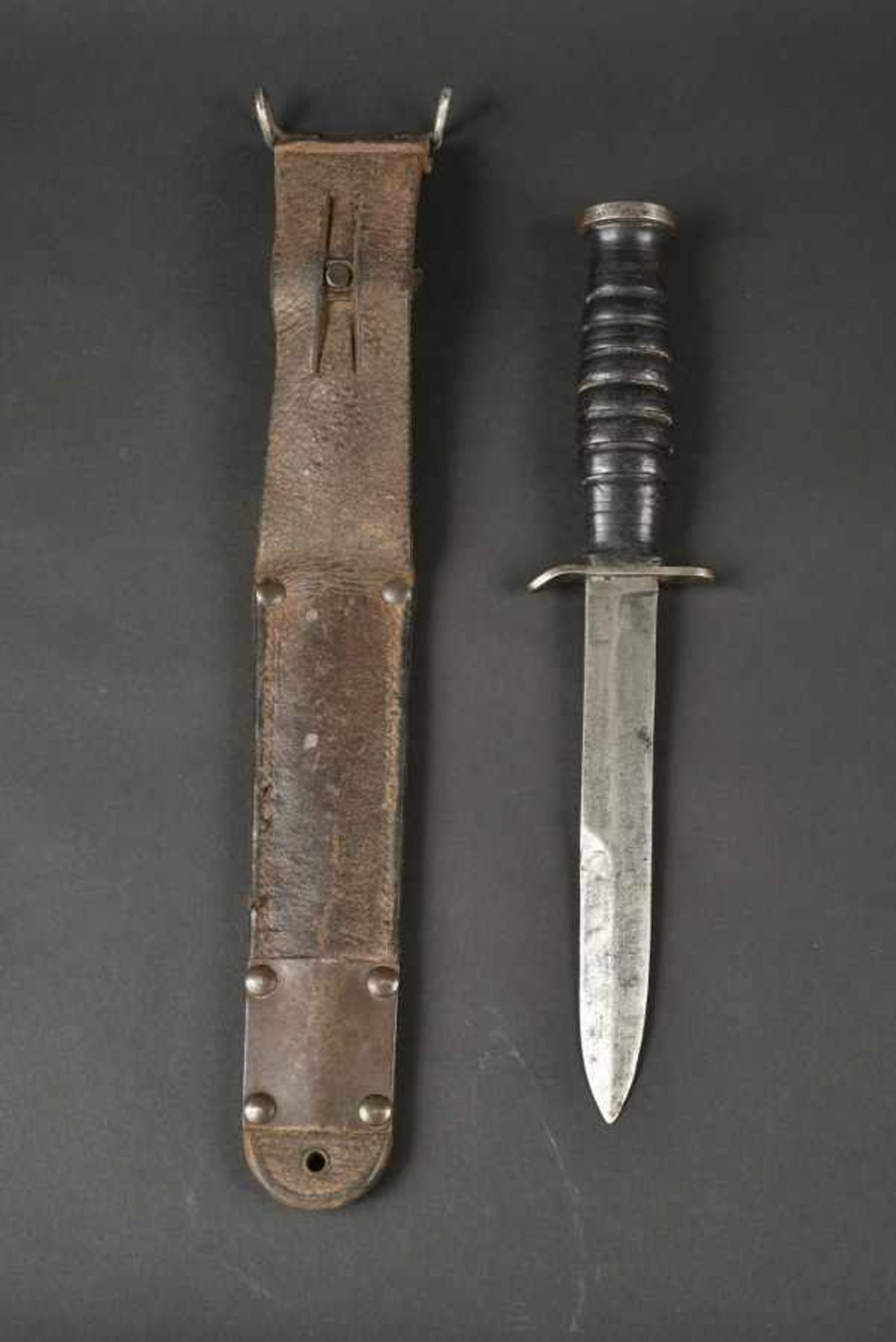12
Couteau USM3 fourreau USM6. USM3 knife USM6 sheathPièce terrain. Poignée composée de huit anneaux en
1/4
Das Auktionshaus hat für dieses Los keine Ergebnisse veröffentlicht
Caen
Beschreibung
Couteau USM3 fourreau USM6. USM3 knife USM6 sheathPièce terrain. Poignée composée de huit anneaux en cuir. Pommeau fortement usé, ne disposant pas de la grenade US. Lame complète, légèrement affûtée à son extrémité, marquée US M3 Case. Fourreau en cuir USM6, fabrication USM6 Milsco 1943, grenade US présente. Huit agrafes métalliques à l'entrée du fourreau. Pièce terrain présentant de nombreuses marques d'usures. Couteau laissé dans son état de découverte. Pièce trouvée à Lithaire dans la Manche par des habitants et récupérée par Bertrand Paris chez ces mêmes personnes. C'est au même encroit qu'a été récupéré la veste de John W Rabencraft. Ce ceinturon a très vraisemblablement été laissé par un parachutiste US engagé dans la bataille toute proche du Mont-Castre qui a eu lieu à la mi juillet 1944 contre les parachutistes allemands. Illustrée page 21 du livre 75 objets du Débarquement de Normandie. Attestation originale de provenance signée de Bertrand Paris jointe avec un exemplaire de l'ouvrage. Authentic battlefield item. Handle made up of eight leather rings. Pommel heavily worn, not having the US grenade. Complete blade, slightly sharpened at its end, marked : US M3 Case. USM6 leather sheath, USM6 manufacture Milsco 1943, US grenade present. Eight metal clips at the entrance of the sheath. This authentic item shows many signs of wear. Knife left as found. The item was found in Lithaire in the département de la Manche by local people and recovered by Bertrand Paris from them. John W Rabencraft's jacket was recovered from the same place. This belt was most likely left by a US paratrooper engaged in the battle near Mont-Castre fought in mid-July 1944 against German paratroopers. An illustration can be found on page 21 in the book 75 objects of the Landings in Normandy. Its provenance is attested by an original certificate under the signature of Bertrand Paris, attached with a copy in the book. Photos supplémentaires sur www.aiolfi.com. Additional photos on www.aiolfi.com. Etat II+
Auktionsdetails
Versand
AGB & Wichtige Informationen
Stellen Sie dem Verkäufer eine Frage
Couteau USM3 fourreau USM6. USM3 knife USM6 sheathPièce terrain. Poignée composée de huit anneaux en cuir. Pommeau fortement usé, ne disposant pas de la grenade US. Lame complète, légèrement affûtée à son extrémité, marquée US M3 Case. Fourreau en cuir USM6, fabrication USM6 Milsco 1943, grenade US présente. Huit agrafes métalliques à l'entrée du fourreau. Pièce terrain présentant de nombreuses marques d'usures. Couteau laissé dans son état de découverte. Pièce trouvée à Lithaire dans la Manche par des habitants et récupérée par Bertrand Paris chez ces mêmes personnes. C'est au même encroit qu'a été récupéré la veste de John W Rabencraft. Ce ceinturon a très vraisemblablement été laissé par un parachutiste US engagé dans la bataille toute proche du Mont-Castre qui a eu lieu à la mi juillet 1944 contre les parachutistes allemands. Illustrée page 21 du livre 75 objets du Débarquement de Normandie. Attestation originale de provenance signée de Bertrand Paris jointe avec un exemplaire de l'ouvrage. Authentic battlefield item. Handle made up of eight leather rings. Pommel heavily worn, not having the US grenade. Complete blade, slightly sharpened at its end, marked : US M3 Case. USM6 leather sheath, USM6 manufacture Milsco 1943, US grenade present. Eight metal clips at the entrance of the sheath. This authentic item shows many signs of wear. Knife left as found. The item was found in Lithaire in the département de la Manche by local people and recovered by Bertrand Paris from them. John W Rabencraft's jacket was recovered from the same place. This belt was most likely left by a US paratrooper engaged in the battle near Mont-Castre fought in mid-July 1944 against German paratroopers. An illustration can be found on page 21 in the book 75 objects of the Landings in Normandy. Its provenance is attested by an original certificate under the signature of Bertrand Paris, attached with a copy in the book. Photos supplémentaires sur www.aiolfi.com. Additional photos on www.aiolfi.com. Etat II+
75 Objects from the Bertrand Paris Collection to Celebrate the D-Day / Axis Powers in WWII, Military Vehicles
Auktionsdatum
Ort der Versteigerung
13, route de Trouville
Caen
14000
France
Für Caen Enchères Versandinformtation bitte wählen Sie +33 (0)231860813.













